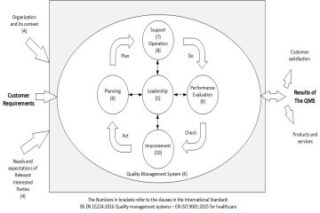Q Exchange
Steps towards a ‘people centric’ QMS for an NHS Trust
- Idea
- 2023

Meet the team
What is the challenge your project is going to address and how does it connect to the theme of 'How can improvement be used to reduce delays accessing health and care services'?
To create an interactive visualisation of the full set of key processes that are required to run a particular Service within an NHS Trust. See example visualisation.
To establish bottlenecks within the Service and key facilities/features that will enable the Service to operate effectively and efficiently.
Two things that are important for the NHS are clarity of work processes and a reduction in error. These two are key outcomes form a well designed QMS. Both also increase productivity – very important for reducing delays in access to care or waiting lists. They are though, a longer term solution but nevertheless very achievable.
Patient safety will also be addressed/included in line with the requirements of PSIRF.
What does your project aim to achieve?
The process documentation, accessed via the interactive visualisation, will facilitate process review, by front line staff, in the following areas: Clinical Audit, H&S, Patients Safety, Quality Control, Sustainability, Risk, Improvement, Data Collection, Error Proofing and others. Using this methodology and QI tools, staff can re-design care processes to best use the time and skills of those using and providing services.
Improved productivity, through Process Management, and the resulting reduction of error can increase patient flow, reduce waiting times and reduce stress in the workforce by empowering and engaging them to collaborate and use improvement methods in reducing waits.
The resulting system design will facilitate data collection in a format that would be suitable for non-conformance reporting, improvement applications, simulation and AI for example.
Importantly this QMS will be designed to include some elements of a Patient Safety Management System (SMS) following the principals of an Aviation industry SMS.
How will the project be delivered?
Establish a MDT design team consisting of people that understand design, NHS Services and Quality Management Systems. The works of Juran and Deming will influence the design as will ISO 9001 – the International standard for quality management. See https://catmalvern.co.uk/Lectures/Lecture05/
How is your project going to share learning?
A well documented QMS Maturity Matrix published.
Webinars and blogs via the Q Community portal.
Collaboration with some of our National institutions, for example the IET, CQI and ICIPS.
Publishing a QMS implementation guide for the NHS – a discussion document.
How you can contribute
- It would be nice to find an NHS Trust to be the lead for this idea. Preferably one that is considering implementing a QMS.
- What have you learnt from watching the video clip? Please tell us in the comment box.
- Tell us if you are implementing or planning to implement a QMS. What are your issues?
- Is following an International standard for a QMS the right way to go? What are your plans?
- Have you thought about how to interface your clinical processes with your new or proposed EPR system? Let us know with a comment.
Comments
Joy Furnival 18 Mar 2023
I love seeing this bid using some of the principles from quality management systems in a healthcare setting, and especially like th3 visualisation ideas in this. Thank you
Thomas John Rose 21 Mar 2023
Joy, I think Mirek's new blog, https://q.health.org.uk/blog-post/back-to-basics-a-simpler-way-of-understanding-qms-for-nhs-organisations/ has gone so way towards linking quality management to a healthcare setting.
Thomas John Rose 18 Mar 2023
Thanks for your comment Joy. I'll add some more links between current healthcare principals and generally Internationally Quality Management principals
Comments are now closed for this post.